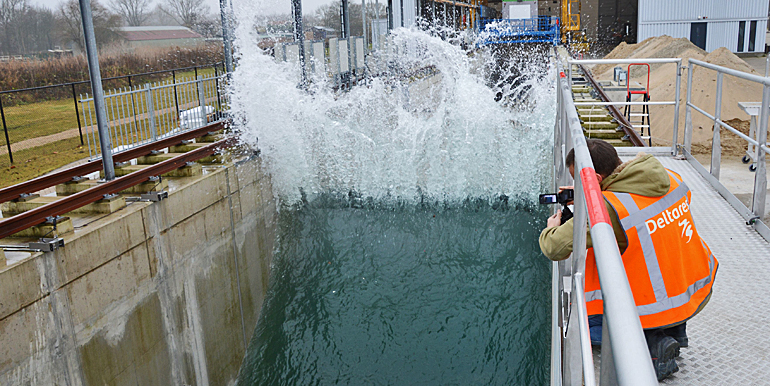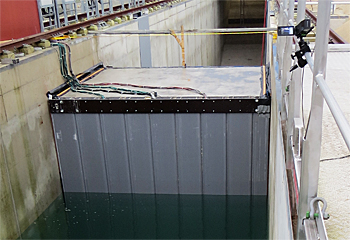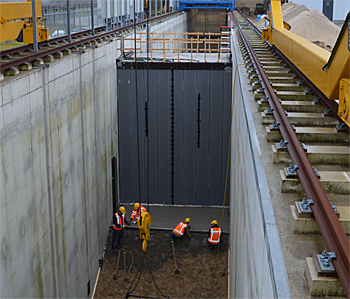Deltares puts vertical composite sea wall to the test in world’s biggest wave flume
 Research institute Deltares is conducting a series of tests on a vertical sea wall, designed by the Australian company Armour Group.
Research institute Deltares is conducting a series of tests on a vertical sea wall, designed by the Australian company Armour Group.
It is for the first time Deltares uses its world’s largest flume facility in Delft, the Netherlands, for a customer outside of the Netherlands.
The armour wall consists of a double set of fabric sheet piles filled with sand.
According to Armour Group their innovative sea wall construction has a significant smaller footprint compared to an earthen levee and is much cheaper compared to concrete.
 A front row of composite interlocked sheet piles, a second row in the back and in between the vertical wall is filled with sand. The concrete floor on top prevents the sand to be flushed out
A front row of composite interlocked sheet piles, a second row in the back and in between the vertical wall is filled with sand. The concrete floor on top prevents the sand to be flushed out
Two rows of composite sheet piles
The innovative sea wall construction consists of a double row of interlocked composite sheet piles that extend above the ground.
The two rows are 4 meters apart and the space between them is filled with sand.
An ingenious system of geogrids that is inserted in the sand, holds the two rows together but providing enough flexibility for the construction to absorb the strong wave forces.
Composite sheet piles are specially coated to resist very demanding marine environment. They also provide high strength and stiffness and they are light weight.
 Construction of a berm at the foot of the sea wall in the 9.5 m deep flume.
Construction of a berm at the foot of the sea wall in the 9.5 m deep flume.
Real-scale construction in Delta Flume
The tests at Deltares provides Armour Group the opportunity for a full scale load testing. The wave flume is 9.5 meters deep, allowing to construct a 8.5 meters high vertical wall.
The tests included water levels up to 6.5 m and waves generated up to 2 meters, with significant wave height up to 1.5 m.
The first tests at Deltares’ Delta Flume show that the vertical wall is strong enough to withstand high tides and heavy waves. It is the first international test in the new Delta Flume.
Bouncing back
Project manager and specialist on coastal structures, Mark Klein Breteler at Deltares is surprised to see that the waves show little impact. “The vertical structure bounces back the waves . Most of the time we see the waves gently lapping against the wall. Only occasionally there comes a wave that really attacks the wall, causing a splash up that overtops it.”
Inventor of the sea wall, CEO John Jarvie at Armour Group is very pleased with the full scale tests by the renowned research institute of Deltares. “We hope that to be able to take back enough data to convince the Australian government that the structure is strong enough for a first application as a real sea wall.”
 Inventor of the sea wall, CEO John Jarvie at Armour Group during a presentation at Deltares in Delft, the Netherlands.
Inventor of the sea wall, CEO John Jarvie at Armour Group during a presentation at Deltares in Delft, the Netherlands.
Very small footprint
Jarvie specially mentions the advantage of the small footprint. “For a conventional earthen levees, you need large volumes of clay and sand. This is costly and such large volumes are not always available. Our construction has a very small footprint and needs only a fraction of the sand volume”.
According to Jarvy this can be any sand, of any texture and can even be polluted.
Jarvie is also keen on attracting the government’s attention of the many small island sates in the Pacific. Due to sea level rise, islands are already disappearing. “People living on those islands have to migrate. This can be prevented with our sea wall.”
The results are also relevant for the Netherlands, adds project leader Mark Klein Breteler. "The use of composite materials for marine constructions is on rise worldwide. The biggest advantage compared to traditional steel structures is that they do not corrode and are much lighter. Also the flexibility is an advantage for sheet piles, because the sand will provide a larger part of the strength, which is cheap construction material.”
Read also on this website
● Deltares simulates monster waves to test stability of smart shaped Hillblock revetment blocks, 27 April 2016
● World’s biggest man-made wave rolls down Delta Flume during inauguration, 6 October 2015
More information
Deltares
Delft, the Netherlands
+31 88 335 8273
www.deltares.nl



